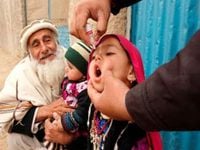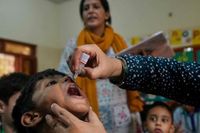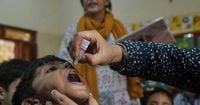Pakistan’s battle against polio has hit another stumbling block, as two new cases of the crippling disease were confirmed in the southern province of Sindh this week. Health authorities reported that the latest victims, both young girls, hail from the districts of Badin and Thatta—an unwelcome development that brings the nation’s total polio case count for 2025 to 29, according to the National Institutes of Health (NIH). The news, reported by outlets including Dawn and the Associated Press, marks a sobering reminder of the challenges still facing public health officials in their decades-long campaign to eradicate the virus.
The fresh cases come mere days after another polio infection was detected in Sindh’s Hyderabad district. The breakdown of this year’s cases underscores the geographic spread of the virus: 18 have been recorded in Khyber Pakhtunkhwa, nine in Sindh, and one each in Punjab and Gilgit-Baltistan. This pattern, as noted by the NIH, reflects both persistent transmission in certain regions and the daunting logistical hurdles of reaching every vulnerable child.
“With these two cases, both girls, the total number of polio cases in Pakistan in 2025 has reached 29, including 18 from Khyber Pakhtunkhwa, nine from Sindh, and one each from Punjab and Gilgit-Baltistan,” the NIH stated, as cited by Dawn.
Despite these setbacks, health authorities have pressed ahead with ambitious vaccination drives. Earlier in September, a sub-national campaign covered 88 districts—including Badin and Thatta—successfully reaching nearly 21 million children under the age of five. The scale and reach of these efforts are staggering: more than 400,000 dedicated frontline workers went door-to-door, braving difficult terrain and, in some cases, personal danger, to ensure that every eligible child received the oral polio vaccine (OPV) and a dose of Vitamin A to boost immunity.
“The campaign successfully reached nearly 21 million children under the age of five,” the NIH reported. “During the campaign, Vitamin A will also be administered alongside the oral polio vaccine (OPV) to boost children’s immunity levels. More than 400,000 dedicated frontline workers will go door-to-door to ensure that every eligible child receives this essential protection.”
The next phase of the fight is just around the corner. A nationwide weeklong campaign is scheduled to run from October 13 to 19, with the goal of immunizing approximately 45.4 million children under five. Authorities are doubling down on their message to parents and caregivers: vaccination is not just a government responsibility, but a shared duty. As the NIH emphasized, “Polio eradication is a shared responsibility. While dedicated frontline polio workers deliver vaccines, parents and caregivers must ensure their children receive all recommended doses, including routine immunisations.”
Polio remains a formidable adversary. The disease is highly infectious and incurable, capable of causing permanent paralysis, particularly in young children. The only reliable defense is prevention—ensuring every child receives oral polio drops during each campaign, alongside timely completion of all routine immunizations. According to the World Health Organization (WHO), Pakistan and neighboring Afghanistan are now the only two countries where wild poliovirus transmission has never been interrupted.
The struggle to reach every child is complicated by a host of factors. Vaccine hesitancy persists in some communities, fueled by misinformation and mistrust. Others live in hard-to-access areas, where rugged terrain or ongoing conflict makes regular outreach nearly impossible. Tragically, health workers themselves are sometimes targeted in violent attacks, especially in regions with a history of militancy. Since the 1990s, more than 200 polio workers and police officers assigned to protect them have been killed, according to reports from the Associated Press. In February 2025, a police officer guarding a vaccination team in Jamrud, Khyber Pakhtunkhwa, was shot and killed—an incident that highlighted the dangers faced by those on the front lines of the eradication campaign.
Despite these challenges, there are signs of progress. The number of polio cases in Pakistan has declined from at least 71 in 2024 to 29 so far in 2025, according to the NIH and Dawn. That’s a significant reduction, though experts caution against complacency. The virus was detected in around 90 districts last year, and Pakistan has a history of missing eradication deadlines. In 2021, for instance, the country reported just five cases, but the tally rebounded to 99 the following year. The pattern is clear: without sustained, coordinated effort, gains can be quickly lost.
The global context adds further urgency. The WHO and its partners launched the Global Polio Eradication Initiative in 1988, inspired by the successful elimination of smallpox in 1980. The goal was ambitious—total eradication worldwide. While the campaign has come tantalizingly close (with only five cases reported in Pakistan and Afghanistan in 2021), setbacks have repeatedly pushed the finish line further away. Pakistan’s experience illustrates both the potential for rapid progress and the ever-present risk of resurgence.
“Rapidly boosting children’s immunity and strengthening protection as part of Pakistan’s ongoing efforts to eradicate polio. Polio eradication is a shared responsibility,” the NIH reiterated in a statement carried by The Tribune. “While dedicated frontline polio workers deliver vaccines, parents and caregivers must ensure their children receive all recommended doses, including routine immunisations.”
The message from health officials is unambiguous: the only effective protection against polio is repeated vaccination. Every child under five must receive oral polio drops during each campaign, along with all essential immunizations. The upcoming nationwide drive will see Vitamin A administered alongside OPV, a strategy designed to further boost children’s immunity and help close the gap on the remaining cases.
Pakistan’s polio eradication campaign is, in many ways, a test of resilience—of its health system, its communities, and its commitment to a polio-free future. The stakes could not be higher. For every child who escapes paralysis, for every family spared heartbreak, the effort is worth it. But as the latest cases in Badin and Thatta show, the finish line is not yet in sight. The coming weeks will be a crucial test of whether the country’s determination and hard-won progress can finally tip the balance against this ancient scourge.


